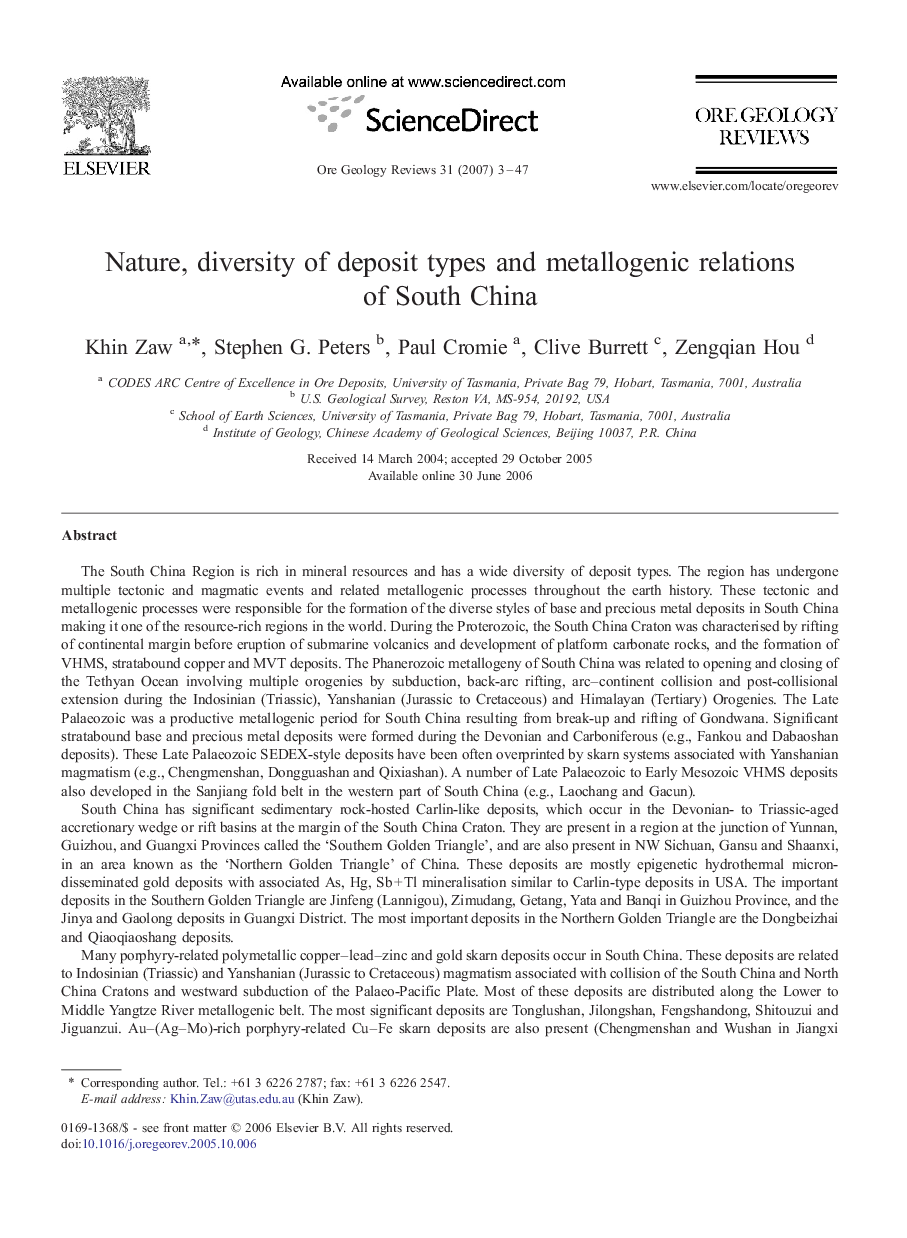| کد مقاله | کد نشریه | سال انتشار | مقاله انگلیسی | نسخه تمام متن |
|---|---|---|---|---|
| 4697947 | 1637270 | 2007 | 45 صفحه PDF | دانلود رایگان |

The South China Region is rich in mineral resources and has a wide diversity of deposit types. The region has undergone multiple tectonic and magmatic events and related metallogenic processes throughout the earth history. These tectonic and metallogenic processes were responsible for the formation of the diverse styles of base and precious metal deposits in South China making it one of the resource-rich regions in the world. During the Proterozoic, the South China Craton was characterised by rifting of continental margin before eruption of submarine volcanics and development of platform carbonate rocks, and the formation of VHMS, stratabound copper and MVT deposits. The Phanerozoic metallogeny of South China was related to opening and closing of the Tethyan Ocean involving multiple orogenies by subduction, back-arc rifting, arc–continent collision and post-collisional extension during the Indosinian (Triassic), Yanshanian (Jurassic to Cretaceous) and Himalayan (Tertiary) Orogenies. The Late Palaeozoic was a productive metallogenic period for South China resulting from break-up and rifting of Gondwana. Significant stratabound base and precious metal deposits were formed during the Devonian and Carboniferous (e.g., Fankou and Dabaoshan deposits). These Late Palaeozoic SEDEX-style deposits have been often overprinted by skarn systems associated with Yanshanian magmatism (e.g., Chengmenshan, Dongguashan and Qixiashan). A number of Late Palaeozoic to Early Mesozoic VHMS deposits also developed in the Sanjiang fold belt in the western part of South China (e.g., Laochang and Gacun).South China has significant sedimentary rock-hosted Carlin-like deposits, which occur in the Devonian- to Triassic-aged accretionary wedge or rift basins at the margin of the South China Craton. They are present in a region at the junction of Yunnan, Guizhou, and Guangxi Provinces called the ‘Southern Golden Triangle’, and are also present in NW Sichuan, Gansu and Shaanxi, in an area known as the ‘Northern Golden Triangle’ of China. These deposits are mostly epigenetic hydrothermal micron-disseminated gold deposits with associated As, Hg, Sb + Tl mineralisation similar to Carlin-type deposits in USA. The important deposits in the Southern Golden Triangle are Jinfeng (Lannigou), Zimudang, Getang, Yata and Banqi in Guizhou Province, and the Jinya and Gaolong deposits in Guangxi District. The most important deposits in the Northern Golden Triangle are the Dongbeizhai and Qiaoqiaoshang deposits.Many porphyry-related polymetallic copper–lead–zinc and gold skarn deposits occur in South China. These deposits are related to Indosinian (Triassic) and Yanshanian (Jurassic to Cretaceous) magmatism associated with collision of the South China and North China Cratons and westward subduction of the Palaeo-Pacific Plate. Most of these deposits are distributed along the Lower to Middle Yangtze River metallogenic belt. The most significant deposits are Tonglushan, Jilongshan, Fengshandong, Shitouzui and Jiguanzui. Au–(Ag–Mo)-rich porphyry-related Cu–Fe skarn deposits are also present (Chengmenshan and Wushan in Jiangxi Province and Xinqiao, Mashan-Tianmashan, Shizishan and Huangshilaoshan in Anhui Province). The South China fold belt extending from Fujian to Zhejiang Provinces is characterised by well-developed Yanshanian intrusive to subvolcanic rocks associated with porphyry to epithermal type mineralisation and mesothermal vein deposits. The largest porphyry copper deposit in China, Dexing, occurs in Jiangxi Province and is hosted by Yanshanian granodiorite. The high-sulphidation epithermal system occurs at the Zijinshan district in Fujian Province and epithermal to mesothermal vein-type deposits are also found in the Zhejiang Province (e.g., Zhilingtou). Part of Shandong Province is located at the northern margin of the South China Craton and the province has unique world class granite-hosted orogenic gold deposits. Occurrences of Pt–Pd–Ni–Cu–Co are found in Permian-aged Emeishan continental flood basalt (ECFB) in South China (Jinbaoshan and Baimazhai in Yunnan Province and Yangliuping in Sichuan Province). South China also has major vein-type tungsten–tin–bismuth–beryllium–sulphide and REE deposits associated with Yanshanian magmatism (e.g., Shizhuyuan and Xihuashan), important world class stratabound base metal–tin deposits (Dachang deposit), and the large antimony deposits (Xikuangshan and Woxi). During the Himalayan Orogeny, many giant deposits were formed in South China including the recently emerging Yulong and Gangdese porphyry copper belts in Tibet and the Ailaoshan orogenic gold deposits in Yunnan.
Journal: Ore Geology Reviews - Volume 31, Issues 1–4, April 2007, Pages 3–47